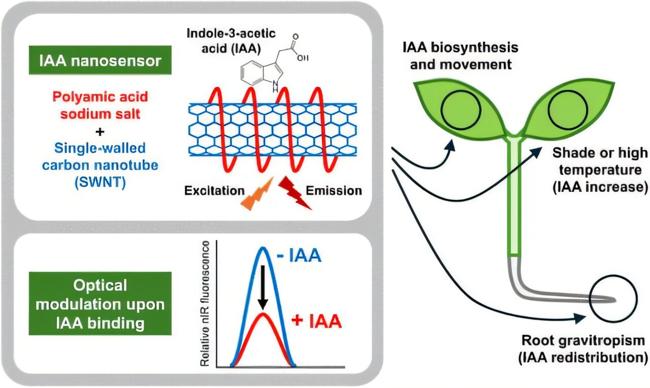Summary
Researchers have developed the world’s first near-infrared (NIR) fluorescent nanosensor capable of real-time, non-destructive and species-agnostic detection of indole-3-acetic acid (IAA)the primary bioactive auxin hormone that controls the way plants develop,
Source: Phys.org

AI News Q&A (Free Content)
Q1: What is the significance of developing a near-infrared (NIR) fluorescent nanosensor for detecting indole-3-acetic acid (IAA) in agriculture innovation?
A1: The NIR fluorescent nanosensor enables real-time, non-destructive, and species-agnostic detection of indole-3-acetic acid (IAA), the main bioactive auxin hormone regulating plant growth. This advancement is significant for agriculture innovation as it allows researchers and farmers to monitor plant hormone levels with high precision, optimizing crop productivity and resource use. Early detection of hormone fluctuations can lead to better management of plant development, stress responses, and yields, supporting climate-smart agriculture and sustainable farming practices.
Q2: How does climate-smart agriculture benefit from real-time hormone tracking technologies like NIR nanosensors?
A2: Climate-smart agriculture seeks to adapt farming methods to changing climatic conditions, enhance productivity, and reduce greenhouse gas emissions. Real-time hormone tracking using NIR nanosensors supports these goals by providing timely data on plant growth and stress responses. This enables informed decisions on crop management, irrigation, and fertilization, directly contributing to increased resilience, better yield forecasting, and reduced input waste, all of which align with climate-smart agriculture objectives.
Q3: What are the key historical milestones in the evolution of agricultural innovation leading up to the use of nanosensors?
A3: Agricultural innovation has evolved from early domestication of crops and livestock over 10,000 years ago to the Green Revolution’s mechanization and introduction of high-yield varieties in the 20th century. The current era is marked by precision agriculture, smart sensors, and biotechnology. The integration of nanosensors represents a recent milestone, enabling molecular-level monitoring of plant health, paving the way for data-driven, sustainable, and efficient agricultural practices.
Q4: What are the economic implications of adopting species-agnostic NIR nanosensors in large-scale agriculture?
A4: Adopting NIR nanosensors in large-scale agriculture can reduce costs through optimized use of fertilizers and water, improved crop yields, and early detection of plant stress or disease. While initial investment in the technology may be significant, the long-term economic benefits include higher productivity, reduced resource wastage, and improved quality of produce, contributing positively to farm profitability and food security.
Q5: What are the advantages and limitations of NIR nanosensors compared to traditional plant hormone detection methods?
A5: NIR nanosensors offer advantages such as non-destructive, real-time, and in vivo monitoring, high sensitivity, and the ability to detect hormones across different plant species. Traditional methods like ELISA or chromatography are often destructive, time-consuming, and require extensive sample preparation. However, nanosensors may require specialized equipment for detection and initial calibration, and their adoption at scale is still emerging.
Q6: What recent scholarly research highlights the use of optical nanosensors for measuring biological forces and plant hormones, and what are its findings?
A6: A 2024 study demonstrated Tm3+-doped avalanching nanoparticle force sensors that can be remotely addressed by near-infrared light, detecting piconewton to micronewton forces with a dynamic range spanning more than four orders of magnitude. These sensors enable operation in dynamic environments, from biological organisms like plants to nanoelectromechanical systems, and are adaptable for multiscale sensing of plant physiological processes.
Q7: How does recent research on surface-enhanced Raman spectroscopy (SERS) relate to hormone detection in biological systems, and what potential does this technique have for agriculture?
A7: A 2024 study used SERS combined with artificial neural networks to detect and quantify hormones in blood samples, showing high accuracy and rapid analysis. While the study focused on animal hormones, the approach's non-specificity and speed suggest potential for plant hormone analysis. This could complement NIR nanosensor technology, providing alternative high-throughput and sensitive methods for hormone monitoring in agricultural research.
References:
- Climate-smart agriculture - https://en.wikipedia.org/wiki/Climate-smart_agriculture
- Agriculture - https://en.wikipedia.org/wiki/Agriculture




